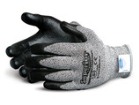
The Revolution in Cut Protection
To put it simply, your father would not recognize the new work gloves on the market today. In fact, these are not even your older brother's gloves.
Ask the average person on the street to describe a work glove, and they will likely describe something that looks like a gardening glove or the gloves they see in big-box home-improvement stores. Ten years ago, the gloves they described would have been very different. The typical gardening glove was largely unchanged for 50 years. Now, in the past decade, it is likely a seamless knit with a latex palm coat.
Gloves popular with the DIY market now are form-fitting, mechanics-style gloves, which did not exist 10 years ago. These are not just cosmetic changes in styles and colors; these are fundamentally different constructions, resulting in better gloves for the job at hand in every measure of the word.
The same revolution in hand protection for the home market has also taken place in the work world. Increasingly, the gloves you see in factories and at job sites across North America are not the same glove styles we grew up with.
So, what types of hand injuries do people sustain at work? After sprains and strains, the second-most-common hand injuries are cuts and lacerations. Thankfully, though, tremendous strides have been made in the last few years in developing new cut-resistant gloves. To put it simply, your father would not recognize the new work gloves on the market today. In fact, these are not even your older brother's gloves.
Today's cut-resistant gloves are made from space-age materials that have revolutionized hand protection. Gloves utilizing materials that are 10 times stronger than steel, on an equal-weight basis. Gloves made from the strongest fibers known to man -- some of which are so lightweight and dexterous, you can pick up a dime, yet are so cut resistant that they withstand repeated slashes from a box cutter. If this is sounding like science fiction to you, then you have not kept up with the advances in glove materials and technology in this new century.
Leather gloves -— once the "king" of work gloves -— used to dominate all medium- and heavy-duty jobs. Cotton canvas -— the "prince" of gloves -— was the undisputed choice for lighter-duty work. These gloves now account for about 25 percent of work glove sales, a percentage that continues to drop year after year. Cost is a major factor among the reasons why: Leather is a pricey material. And cotton canvas, while inexpensive, is a
labor-intensive glove style that has now been largely replaced by more cost-effective, string-knit glove styles.
Performance Makes the Difference
It is performance that is the bigger reason. For the important issue of cut protection, leather cannot hold a candle to the new glove materials. We think of leather as very tough and strong; after all, look at cowboys or motorcycle riders. Why do they continue to wear protective apparel made of it? Well, for abrasion, leather is hard to improve on. If you fall off a motorcycle at 60 miles per hour and are skidding across
the pavement, it is indeed a very good material to be wearing. But for cut protection, it is no better than the skin on your hand -— which is to say, very poor.
Kevlar® and Dyneema® are two competing materials being used in a lot of work gloves you see now. Both offer five to ten times the cut protection of leather. These space-age materials are both used in bulletproof vests, and both are considerably stronger than steel on an equal-weight basis. Leaf through any safety magazine and you'll encounter many pages advertising new glove styles made from these cutting-edge materials, few of which were available prior to the year 2000. Very recently, the bar of cut resistance was raised even higher in hand protection, with the advent of more styles incorporating stainless steel into both Kevlar® and Dyneema®.
All of which might prompt you to ask: If Kevlar® and Dyneema® are stronger than steel, how would adding steel improve the overall cut resistance? Well, there are several reasons. For one, the claim of being stronger than steel is always followed by the words "on an equal-weight basis." But on a cross-sectional basis, steel wire is stronger than the equal volume of Kevlar® or Dyneema®. To put it a different way, pound for pound, Kevlar®
is much stronger than steel, but a steel-mesh glove (though heavy) is stronger than a Kevlar® glove. Also, by engineering how these cut-resistant materials are twisted and plied together, textile engineers are able to get higher cut-resistance values than the sum of their parts would suggest. One can think of it as reinforcing concrete with steel rebar, making something that's already strong even stronger.
There are Kevlar®/steel and Dyneema®/steel combination gloves on the market now, offering 20 times the cut resistance of comparable-weight leather gloves. Now, if that's not a revolution in hand protection, what is?